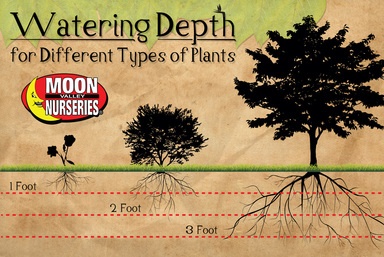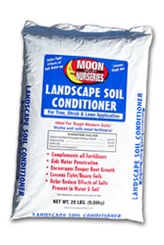A big challenge for many homeowners is understanding proper watering for the material in our landscape. Understanding proper techniques is especially important when we transition from one season to another. As the Valley begins to cool down, it is important to get out into our yards and ensure that everything in the landscape is receiving ample water.
During the winter, cooler days and less sunlight cause the soil to stay moist for a longer period of time. Our nursery experts recommend decreasing the frequency you water your trees and plants from November to February.
We've put together a handy guide that looks at the components and importance of understanding the proper watering methods and irrigation schedule for your landscape.
There are four key components:
-WHERE to place the water
- HOW MUCH to apply
- HOW FAST to apply
- HOW OFTEN to apply
It's important to remember that various factors such as weather, plant maturity, plant/tree type, and soil type affect these components.
WHEN TO WATER: The best and most ideal time to water the material on your landscape is in the morning when the ground is at its coldest point. This allows the water to penetrate deeper into the soil without losing too much due to evaporation.
WHERE TO WATER: Absorbing roots usually spread 1 1/2 to 3 times as wide as the canopy and are within 1 to 3 feet of the soil surface. IT IS IMPORTANT TO WATER AROUND THE TREE AND NOT JUST AT THE BASE.
 HOW MUCH WATER:
HOW MUCH WATER:
It is important to know the water depth for the following.
Trees - 3 feetShrubs - 2 feet
Flower - 12-18 inches
You are going to want to apply enough water to wet the soil. Use a pointed metal rod to test how deeply you have watered by inserting it into the ground soon after you irrigate. The rod will effortlessly slide through the wet soil and become difficult to push when it reaches the dry soil.
HOW FAST: Water should be applied only as quickly as it can be absorbed by the soil. Applying water too quickly causes erosion, wastes the water and compacts the soil surface.
HOW OFTEN: The soil should be allowed to dry out between watering. The weather, plant/tree maturity, plant/tree type, soil type and irrigation method are all key factors determining where to place the water, how much to apply and how often to apply water.
WEATHER: During the winter, you want to decrease the frequency you water your plants and trees. The cooler temperatures and less sunlight allows the soil to stay moist for a longer period of time.
PLANT MATURITY: Newly established trees and plant may require more frequent water in winter months compared to mature trees and plants. Still remember to check the soil so you don't over or under water the material in your landscape.
IRRIGATION/WATERING METHODS
The type of watering method will determine how long it will take to adequately water your plants/trees.
DRIP IRRIGATION: Be sure to have enough well-placed emitters to cover the entire root ball. Program the system to run long enough to apply enough water to penetrate the roots of the tree or plant.
BUBBLERS: Be sure the basins are level and extend beyond the of the canopy.
FLOOD IRRIGATION: This is an excellent technique developing deep-rooted trees.
HOSES: A perforated soaker house spread throughout the root zone is an effective device for watering trees and can be set under the mulch.
Additional TIPS FOR EFFICIENT WINTER WATERING:

- 3 to 4 inches of mulch applied under the canopy will keep soils cool, reduce water loss through evaporation and discourages weeds.
- Leach out salts from the root zone twice a year by applying MOON VALLEY SOIL & WATER CONDITIONER.
- Use MOON VALLEY NURSERY FERTILIZERS & NUTRIENTS for optimal growing in our tough desert conditions.

Submit a Comment